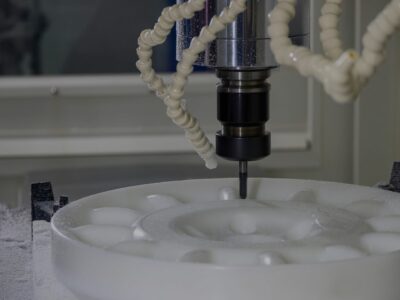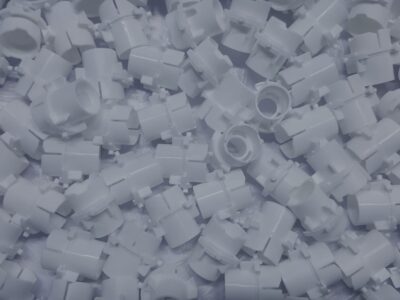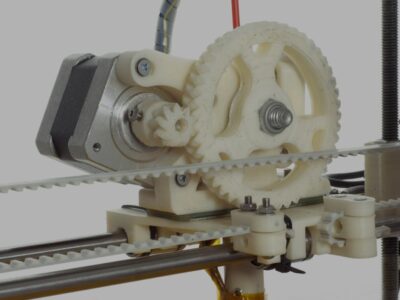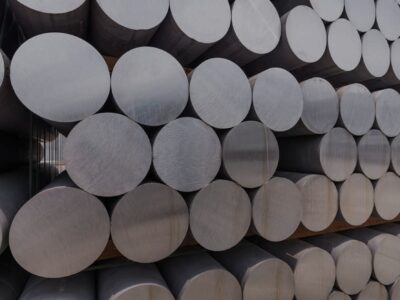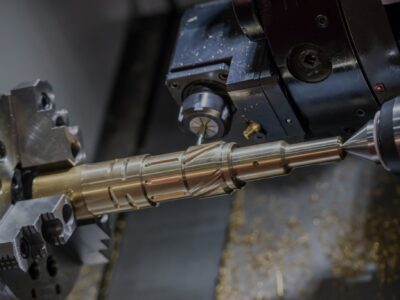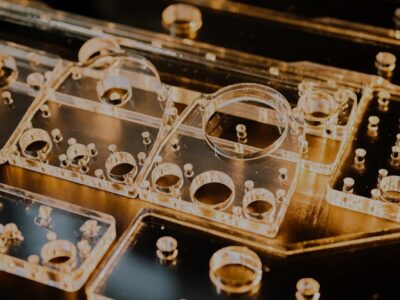Originally published on fastradius.com on February 25, 2021
Plastics are integral to the modern manufacturing industry — they’re widely available, most are affordable, and they’re compatible with popular manufacturing processes like injection molding, 3D printing, and CNC machining.
CNC machining is a subtractive manufacturing process that uses rotating tools and drills to systematically remove material from a solid block of material, thereby shaping the part. When it comes to manufacturing plastic parts, CNC machining is more precise than injection molding. What’s more, CNC machining is compatible with a wider range of plastics than many other manufacturing methods, making parts production via machining a desirable choice for many product teams. Here are 11 of the most common CNC machining plastics available today:
11 common CNC plastics
1. Acrylonitrile Butadiene Styrene (ABS)
ABS is a popular engineering thermoplastic known for its impact strength and resistance, high heat resistance, and good machinability. This plastic is a good insulator, ideal for electrical applications, and remains mechanically stable over time.
Since ABS is so lightweight, affordable, and widely available, many product teams use it for rapid prototyping. Other common applications include electronics enclosures, keyboard caps, and dashboard components in cars.
Even though ABS is strong, it’s highly susceptible to wear by certain greases, solvents, and alcohols. Also, ordinary ABS grades that haven’t been treated with modified with heat stabilizers burn easily and will sometimes continue to burn even after the flame has been removed.
Mechanical specifications:
- Elongation at break: 10 – 50%
- Flexural modulus: 1.6 – 2.4 GPa
- Tensile strength: 29.8 – 43 MPa
- Hardness shore D: 100
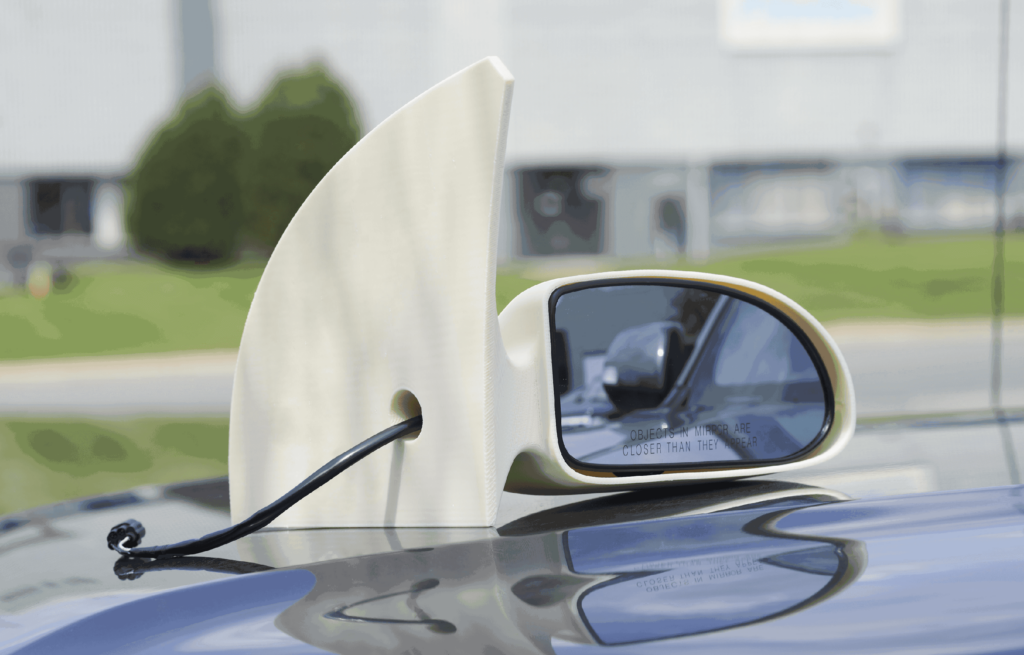
2. Nylon 66
Nylon, also known as polyamide (PA), is a broad category of low-friction engineering thermoplastics with high impact strength, high abrasion and chemical resistance, and overall excellent mechanical properties.
Nylon 66 is particularly well-suited for CNC machining because it’s strong and durable enough for a wide variety of applications in many industries including automotive and medical devices. This plastic is naturally high-performing, can withstand a lot of wear and tear, and resists damage from oil and fuel. However, nylon 66 has low dimensional stability when it takes on moisture, and it takes on moisture very easily. It also doesn’t hold up well in the presence of strong mineral acids.
- Elongation at break: 150 – 300%
- Flexural modulus: 2965 MPa
- Tensile strength: 76 MPa
- Hardness: 116, Rockwell R
3. Polyetheretherketone (PEEK)
PEEK is a high-performance thermoplastic known for its unusual combination of mechanical properties. This plastic is resistant to chemicals, wear, creep, fatigue, liquids, and temperatures up to 260°C (480°F). It’s also lightweight, strong enough to endure harsh environmental conditions, and insoluble in all common solvents. Plus, PEEK is recyclable and biocompatible.
Like nylon, PEEK is often used to replace metal in CNC machining. Common applications include piston units, critical airplane engine parts, and dental syringes.
For all of its strengths, PEEK isn’t resistant to UV light and doesn’t hold up well in the presence of halogens or sodium. Also, it’s one of the more expensive CNC machining plastics on the market — product teams should only consider using it for their most demanding applications.
Mechanical specifications (unfilled PEEK):
- Elongation at break: 30 – 150%
- Flexural modulus: 3.7 – 4 GPa
- Density: 1.26 – 1.32 g/cm3
- Toughness (Notched Izod Impact at Room Temperature): 80 – 94 J/m
4. (Polyacetal polyoxymethylene) POM
Most commonly known by its commercial name, Delrin, POM is the one of the most machinable of all CNC plastics. Product teams choose POM when they need a high-strength, high-stiffness plastic with excellent heat, wear, weather, chemical, and fuel resistance.
Delrin 570 and 150 are the most common grades of POM used in CNC machining because they have excellent dimensional stability and are ideal for creating precise parts with tight tolerances. However, this plastic has poor resistance to acids. Plus, it can be difficult to bond. Common applications for POM include seat belt components, electronic cigarettes, insulin pens, and water meters.
Mechanical specifications (Delrin 570):
- Tensile modulus: 4900 MPa
- Flexural modulus: 4600 MPa
- Impact strength, notched IZOD: 6 kJ/m²
- Tensile strength at break: 53 MPa
5. Polycarbonate (PC)
PC is well known and widely used in the manufacturing industry. It’s tough but lightweight, naturally heat retardant, and offers excellent electrical insulation properties. PC is also more efficient than other engineering thermoplastics.
Designers should know that PC is naturally transparent and can transmit light as well as glass — plus it takes on color very well. Common applications include safety goggles, surgical implements, circuit breakers, and CDs/DVDs.
Unfortunately, PC’s good mechanical properties will degrade after prolonged exposure to water over 60°C. Also, although PC is resistant to diluted acids, oils, and greases, it’s susceptible to hydrocarbon wear and will yellow over time after prolonged exposure to UV rays.
- Elongation at break: 50-120%
- Flexural modulus: 2.2-2.5GPa
- Tensile strength at break: 55-77MPa
- Hardness shore D: 90-95
6. Polytetrafluoroethylene (PTFE)
PTFE, commonly known as Teflon, is a versatile high-performance polymer with a number of mechanical properties that make it valuable for product teams designing commercial products. This plastic is chemical-, temperature-, light-, UV-, water-, weathering-, and fatigue-resistant. Known for its excellent anti-adhesion properties, PTFE is most commonly found in the coatings for non-stick pans, but it is also used for gaskets, semiconductor parts, and even heart patches.
PTFE has the lowest friction coefficient of any solid material and is one of the top five most corrosion-resistant plastics. However, PTFE’s mechanical properties are generally inferior to other engineering plastics at room temperature — though this can be remedied by adding appropriate fillers. It’s also important to note that there are limits on the thickness of parts made with PTFE since it’s typically only available in two-inch thick plates or rods. PTFE is also sensitive to creep and abrasion.
- Elongation at break: 300-550%
- Tensile modulus: 550 MPa
- Dielectric strength: 19.7 kV/mm
- Dynamic coefficient of friction: 0.04
7. High-density polyethylene plastics (HDPE)
HDPE is a flexible, easy-to-process plastic that’s resistant to stress cracking, chemicals, and corrosives even at low temperatures. It offers the same exceptional impact strength of low-density polyethylene (LDPE) with a tensile strength that’s four times higher. However, this material has poor UV resistance. Common applications include plugs, seals, and electrical insulators.
Mechanical specifications:
- Elongation at break: 500%
- Tensile strength: 4,000 PSI
- Density: 0.035 lbs / cu. in.
- Hardness: Rockwell R65
8. Ultra-high molecular weight polyethylene (UHMW)
UHMW is a tough, versatile, and highly machinable plastic with high abrasion and wear resistance. Product teams turn to this material when they need a durable, low-friction plastic for their industrial applications.
Product teams must keep in mind that UHMW isn’t suitable for high load applications because it’s highly susceptible to creep, and shouldn’t be used in temperatures exceeding 80 to 100°C. UHMW is commonly found in truck bed liners, food processing machinery parts, wear strips, and marine dock fender pads.
Mechanical specifications:
- Tensile strength: 3,100 PSI
- Flexural modulus: 110,000 PSI
- IZOD impact (notched): 18.0
9. Polymethyl methacrylate (PMMA)
PMMA, commonly known as acrylic or acrylic glass, is a rigid thermoplastic widely known for its shatter-resistance. It’s tough, lightweight, resistant to most laboratory chemicals. It does, however, break down when used with chlorinated or aromatic hydrocarbons, ketones, or ethers.
Compared to polystyrene, PMMA transmits light better and is more weathering- and UV-resistant. From a design standpoint, this plastic offers unlimited coloring options and a refractive index of 1.49.
However, PMMA is not very resistant to heat, impact, wear, or abrasion. Also, this material is prone to cracking under heavy loads. As such, product teams should only consider PMMA for low-stress applications like greenhouse canopies, car indicator light covers, solar panels, and drug testing devices.
Mechanical specifications:
- Elongation at break: 2 – 10%
- Flexural modulus: 2.5 – 3.5 GPa
- Hardness shore D: 90 – 99
- Tensile strength at break: 38 – 70 MPa
10. Polypropylene (PP)
Polypropylene is a cost-effective CNC machining plastic that offers a unique combination of properties not found in many other plastics. It’s lightweight, highly chemical resistant in corrosive environments, and resistant to most organic solvents, degreasing agents, and electrolytes.
Compared to LDPE and HDPE, PP has a lower impact strength but it makes up for it in tensile strength. Similar to PTFE, PP is typically limited to three-inch sheets for machining, so part size is limited.
- Tensile strength at yield: 4800 PSI
- Flexural strength: 5400 PSI
- Flexural modulus: 160,000 PSI
- Hardness: 80 Rockwell R
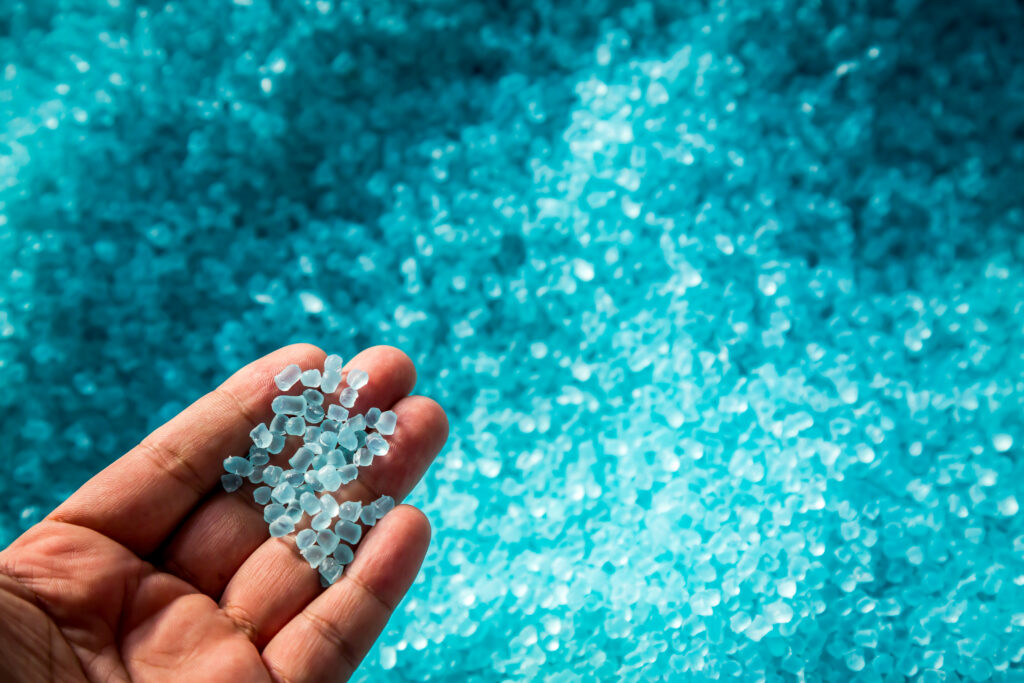
11. Low-density polyethylene (LDPE)
LDPE is a tough but flexible CNC machining plastic known for its low-temperature flexibility and corrosion resistance. It’s easy to weld and heat seal and offers good chemical resistance.
LDPE is primarily used for orthotics and prosthetics. However, LDPE shouldn’t be used for applications in which stiffness, high structural strength, and high-temperature resistance are required. Part size is also limited because of thickness limitations on commercially available LDPE.
Mechanical specifications:
- Tensile strength: 1,400 PSI
- Flexural modulus: 30,000 PSI
- IZOD impact strength (notched): no break
Get started with SyBridge Technologies
CNC machining is a versatile manufacturing process that allows product development teams and engineers to create high-quality parts with complex geometries. However, since CNC machining is compatible with almost any material that can be machined, engineers are spoiled for choice. Wading through all of the possible options and choosing the material that’s best for their use-case can be challenging and time-consuming.
A seasoned manufacturing partner like SyBridge Technologies can streamline the material selection process. Our team has years of experience seeing customers through the entire manufacturing process — from design optimization and material selection to production and speedy fulfillment. We’re well-equipped to help product teams zero-in on the CNC machining material that’s right for their unique projects. Contact us today to get started.
